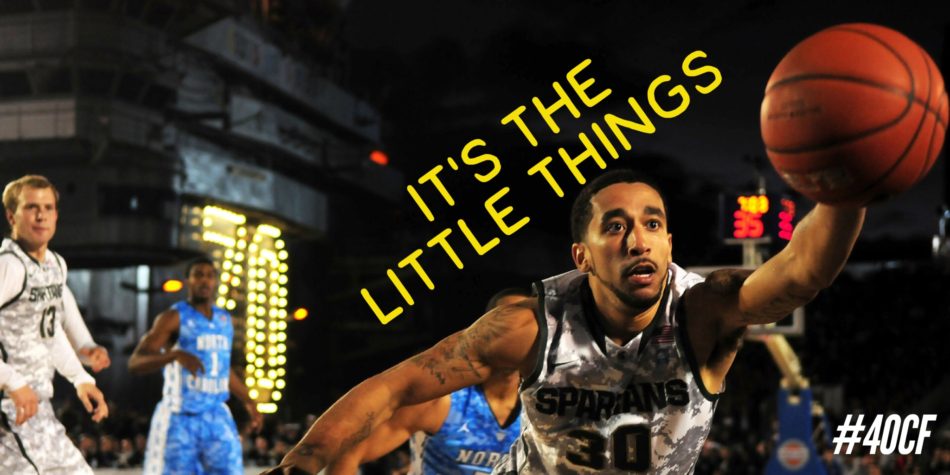“It’s the little details that are vital. Little things make big things happen.”
John Wooden, UCLA Basketball Coach, Winner of 10 NCAA National Championships
As I watched the Sweet Sixteen and Elite Eight rounds of the NCAA Basketball tournament this weekend, I was struck by the repeated mentions by announcers of the same strategies and themes that come up every year during tournament time. As the tournament, which starts with 68 teams, winds down to 1 ultimate winner, it seems as though there are certain “little things” that teams can do in order to defeat their opponents. Throughout the history of the tournament, the teams who have applied these lessons seem to have found tremendous success. As I listened to the announcers continue to mention the little things, I thought about how they might apply to the classroom. Could these same details help make students successful? Ultimately, I realized that the little things that basketball coaches and players seek to accomplish can also help students to be successful.
Here are several strategies for accomplishing the “little things” in your classroom:
Take the high percentage shot. In basketball, coaches and announcers always refer to this shot, the one that goes in at the highest percentage. Generally, a layup is the highest percentage shot, because of its proximity to the basket. In education, a high percentage shot can refer to those best practice strategies that you know will work with students. For example, pre-teaching vocabulary prior to a reading selection can help students with their comprehension of the selection. Cooperative learning can be utilized to improve student outcomes. Using high percentage strategies can help students reach their learning goals. Make sure that you are using established strategies that you know to be successful.
Make the extra pass. This refers to continuing to pass the ball until you get a high percentage shot. Sometimes, making the extra pass means turning down a good shot to get a better shot. Often two passes may lead to a good shot, but the extra third pass may lead to a wide-open shot. In the classroom, this can refer to providing each student with the extra support that they may need in order to be successful. While providing a study guide prior to a test may help most students, some students may need the extra pass, possibly a study session to ensure that they have mastered material and can review what they still don’t understand. It is important to always take that extra step in order to support students.
Fundamentals win games. Teams often win games because of the basic fundamentals that players have mastered. Boxing out in order to grab a rebound, taking a charge on defense, or simply making free throws often make the difference in a game. Anyone who has ever played or watched basketball understands the importance of a fundamental skill like shooting free throws. Mastering fundamentals often makes a huge difference for students as well. Students who learn their basic math facts set themselves up for later success. Students who master the basics of reading can become lifelong readers, and help improve their writing as well. Helping students to master other fundamentals, such as organization and research skills, can prepare them for success in many other areas. The work done to ensure that students master fundamentals will always be important work.
Master the Art of the Pivot. All players must learn to pivot. Establishing a pivot in basketball allows a player to move in multiple directions. A successful player masters the pivot and footwork in order to utilize multiple moves against their opponent. In the classroom, a teacher must also have the ability to pivot. Allowing yourself to move in multiple directions can help you be a better teacher. If one strategy is not working, pivot, change your direction, and try another strategy. As you notice your planned approach not working during a lesson, don’t wait until the next day to regroup, master the art of the pivot. Let the students know that the approach is not working (this is a great way to model failing forward!), pivot, and try a different approach. Don’t be afraid to change anything that is not working.
Survive and Advance. This mantra is used as teams compete in the single loss elimination NCAA tournament. If a team wins, they advance in the tournament. If a team loses, they are out. Sometimes, a team that wins feels as if it survived. With all of the mandated initiatives and new programs being implemented in today’s educational landscape, it can also feel as if a teacher is in survival mode. However, just like successful teams in the tournament, a teacher must learn to survive and advance. While some mandated initiatives are beneficial and some are not, a successful teacher must learn to navigate the two, and still continue to advance what is important for students. In my classroom, kindness and caring were the overarching goals for students and teachers. While implementing new curriculum programs, preparing for state tests, and trying to learn new initiatives, we always came back to the goals of the classroom. We constantly advanced the class goals of kindness and caring, above all else.
While you may find it time consuming to focus on the little things in your classroom, the time spent may ultimately improve the big picture of your classroom, creating meaningful student engagement, positive learning outcomes, and a culture of success. Much like the teams that find success during the NCAA tournament, teachers can use little things effectively. Remember, it is the little things that add up to cause big things to happen. Let us know what little things you have focused on in your classroom. Share in the comments section below.
By Rich Czyz @RACzyz


